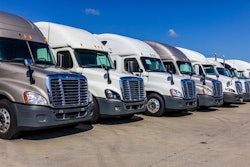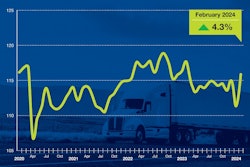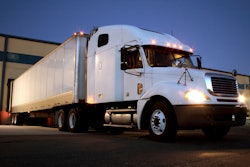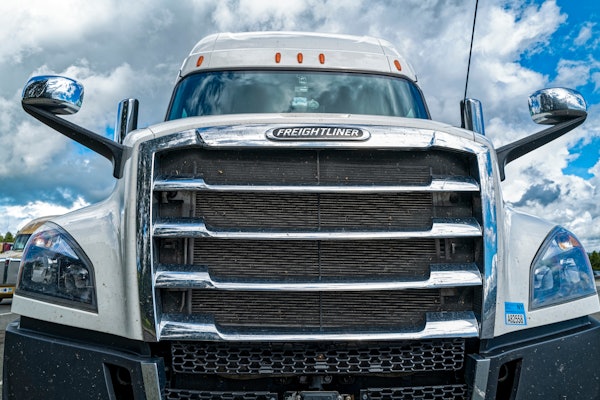For the first time in 20 years China is no longer atop the list of U.S. imports. U.S manufacturing has undergone a near-shoring campaign for many years, driven in part by rising political tension between the U.S. and China, and that's pushed Mexico to the top of the import heap.
Contents of this video
00:00 10-44 intro
00:28 U.S manufacturing and nearshoring
02:17 Freight traffic between borders
04:49 Infrastructure and freight flow
06:01 Technology solutions for cross border freight
07:25 AI for decreasing risks
Jason Cannon (00:00):
CCJs 10-44 is brought to you by Chevron Delo, heavy duty diesel engine oil. Now there's even more reasons to choose Delo.
(00:09):
The US has a new top import partner, and that's good news for freight.
(00:14):
You're watching CCJs 10-44, a weekly webisode that brings you the latest trucking industry news and updates from the editors of CCJ. Don't forget to subscribe and hit the bell for notifications so you'll never miss an installment of 10-44.
(00:28):
Hey everybody, welcome back. I'm Jason Cannon and my co-host on the other side is Matt Cole. For the first time in 20 years, China is no longer a top of the list of US imports, and that's a title that now belongs to Mexico.
Matt Cole (00:40):
US manufacturing has undergone a nearshoring campaign for many years, driven in part by rising political tension between the US and China.
Jason Cannon (00:48):
Another consideration is that during the pandemic, we all had a front row seat for the unraveling of an overseas reliant supply chain. Joining the 10-44 this week is Netradyne Head of Fleet Safety, Barrett Young, and he says that kind of face plant likely accelerated this shift that was already underway, politics aside.
Barrett Young (01:06):
It totally makes sense that this shift is happening regardless of you like it or not. Removing the politics aside, the shift is happening and has happened, and I think the conversations have been happening internally within the United States for several years, but I think what happened during COVID and essentially the breakdown of our entire supply chain that came from China really was the straw that broke the camel's back. There are technology companies like ourselves that were increasingly impacted by the complete stoppage of hardware pieces or technology that is required to be produced by Chinese manufacturers. That just fell off a cliff. It was no longer there, and so as most companies did, and now as the United States government is looking to do, it's like how do we remove the dependency so greatly into one single source that then only continues to add risk if something begins to not work, which is exactly what we experienced during 2020 and 2021.
Matt Cole (02:10):
How that shift is affecting freight flow isn't quite as simple as saying traffic at the ports will go down as cross border traffic goes up.
Barrett Young (02:17):
Freight traffic between borders like with Canada and Mexico will absolutely continue to increase if that's the direction that the United States government is beginning to source. That's not to say there wouldn't be other port sources. For example, if we find, and this is a very big hypothetical, but if we find manufacturing facilities in the Philippines, they actually turn out to be great for us, then port activity continue would maintain. I think the bigger question though is does the cross border traffic continue to increase and I think that's the nearshoring idea begins to point in that direction.
Jason Cannon (02:57):
So what happens to infrastructure when a shift in traffic and freight flow happens? It was expected but not necessarily planned for when the infrastructure was built out. Barrett tells us after a quick word from 10-44 sponsor Chevron lubricants.
Speaker 4 (03:11):
These past few years have been less than easy. We've encountered challenges we never imagined we'd ever have to deal with from makeshift home offices and video meetings to global supply chain uncertainty, price instability, market disruptions, and everything in between. Delivering the level of services and products our customers had come to expect was difficult for all of us. We can't change what's behind us, but we can definitely learn from it. We can adapt, evolve, and take steps to reset our thinking, adapt our strategies, and restore your trust in us to better meet your needs now and in the future. That change begins today. Today we break with convention and introduce a rebalance line of Delo heavy duty engine oils. We've reduced our product line from four categories to two. Consolidated and simplified, this lineup removes complexity from the manufacturing processes, enhancing price stability and supply chain reliability so you can trust you'll have the premium products you need to keep your business always moving forward.
(04:23):
Our break with convention optimizes the Delo lineup to allow you to provide your customers with the best synthetic blend and synthetic heavy duty engine oils in the market, fully available at prices you can rely on. It's your assurance that you'll be well positioned to be their trusted source for proven engine protection that keeps equipment on the job, giving your customers even more reasons to choose Delo.
Barrett Young (04:47):
There are two ways of looking at it, right? There's a reactive way and there's a proactive way. In situations like the cross border increase in traffic right now, it seems very reactive. We said, "All right, China's no longer fulfilling what we need to be done, so what's our next best option? Mexico and Canada seem to be a great option, and for that, let's move in that direction because the priority is to continue the flow of goods in and out of the country." Now, to your point, if the infrastructure isn't currently existing to maintain that increased flow, then we begin to run into bottlenecks, and that's the reactive approach of now the US government saying, "Okay, cool. This is going to be our new normal, our new way of doing things. Then we need to address how we improve the infrastructure in those areas."
(05:32):
The good news is there's lots of conversations happening in the capital about how we improve infrastructure and all the different bills available to make it better, and that is just a simple evolution of how growth happens. So it may be a challenge now, but I don't foresee it continuing to be a challenge if this truly is the nearshoring direction that everyone's moving towards.
Matt Cole (05:52):
We're basically in a period of growing pains, but there are technology solutions available to help, especially when you consider the risks associated with increased truck traffic.
Barrett Young (06:01):
By having more road traffic versus ship traffic, that inherently increases additional risk on the road. More vehicles, especially more heavy vehicles, increases the chances of accidents or collisions or just incidents in general across the road, especially when they're going back and forth between borders because there's different laws, different regulations. Right now, it's a bottleneck to a degree, and so technology serves actually as a very good resource both for the fleets and even the local governments to understand what actually is happening on the road. So technology like Netradyne's Driver.i, which the video-based telematics solution can provide everything from fleet management like GPS locations of all the different vehicles both in and out. For example, our technology works equally as well in Mexico as it does in the United States, and we have many fleets located in Texas that drive cross border on a daily basis. As a fleet manager, you're able to understand exactly where all of your vehicles are, the performance, the diagnostics, the maintenance, everything you would need to know about what's happening in those vehicles.
(07:08):
And of course, given the scenario of if you're shipping goods and services, there's always risk that comes along with that and be able to have video-based evidence of incidents that happen is only going to continue to make the fleet safer, the driver safer, and the fleets themselves more productive.
Jason Cannon (07:25):
You can't mention the word technology and not include artificial intelligence, especially when it comes to decreasing risks.
Barrett Young (07:32):
As a US driver, I understand very much what I can and can't do on the US roadways. I rarely, in fact, I've only driven once in my entire life, but anytime you drive overseas, there are different rules of the road. There's different signs can be different, and just traffic patterns are different, expectations are different, and just with that, the risk profile is different. Not saying that it's more risky or less risky, it's just different. And so with that, the driver who's going back and forth has to be able to adjust dynamically to that different type of risk profile and having an AI camera system that can help the driver, this is a copilot situation where it can change to adjust and monitor what's happening in a Mexico roadway or a Canadian roadway to say, "This is what you should avoid. These are the good things you're doing, and here's how to continue to remain safe." And that's the biggest goal.
(08:26):
And when they go cross border, you run into a whole nother scenario of situations, right? The risk profile of Mexico is going to be very different than the risk profile of the United States, and even the laws of the roadways are different to some degree, and so being able to have access to that information, driver coaching and video evidence and telematics and things only increases the safety and the performance of the fleet overall. And so as we are going to be moving back and forth between those borders, Mexico and Canada, then giving fleets more power at their fingertips to make their fleet successful using technology like Netradyne's Driver.i is only just a no-brainer.
Jason Cannon (09:06):
That's it for this week's 10-44. You can read more on CCJDIGITAL.com. While you're there, sign up for our newsletter and stay up to date on the latest in trucking industry news and trends. If you have any questions or feedback, please let us know in the comments below. Don't forget to subscribe and hit the bell for notifications so you can catch us again next week.










